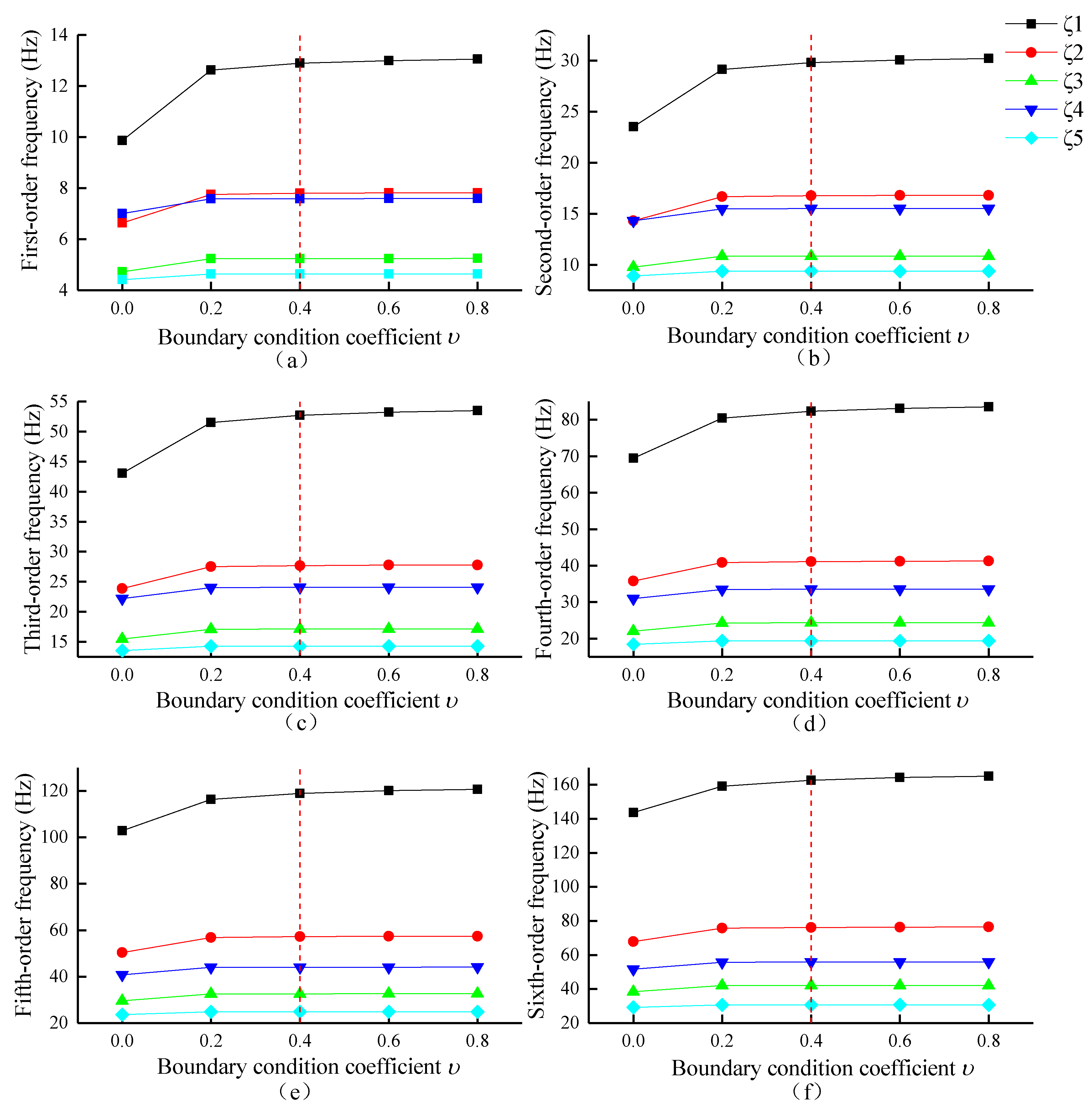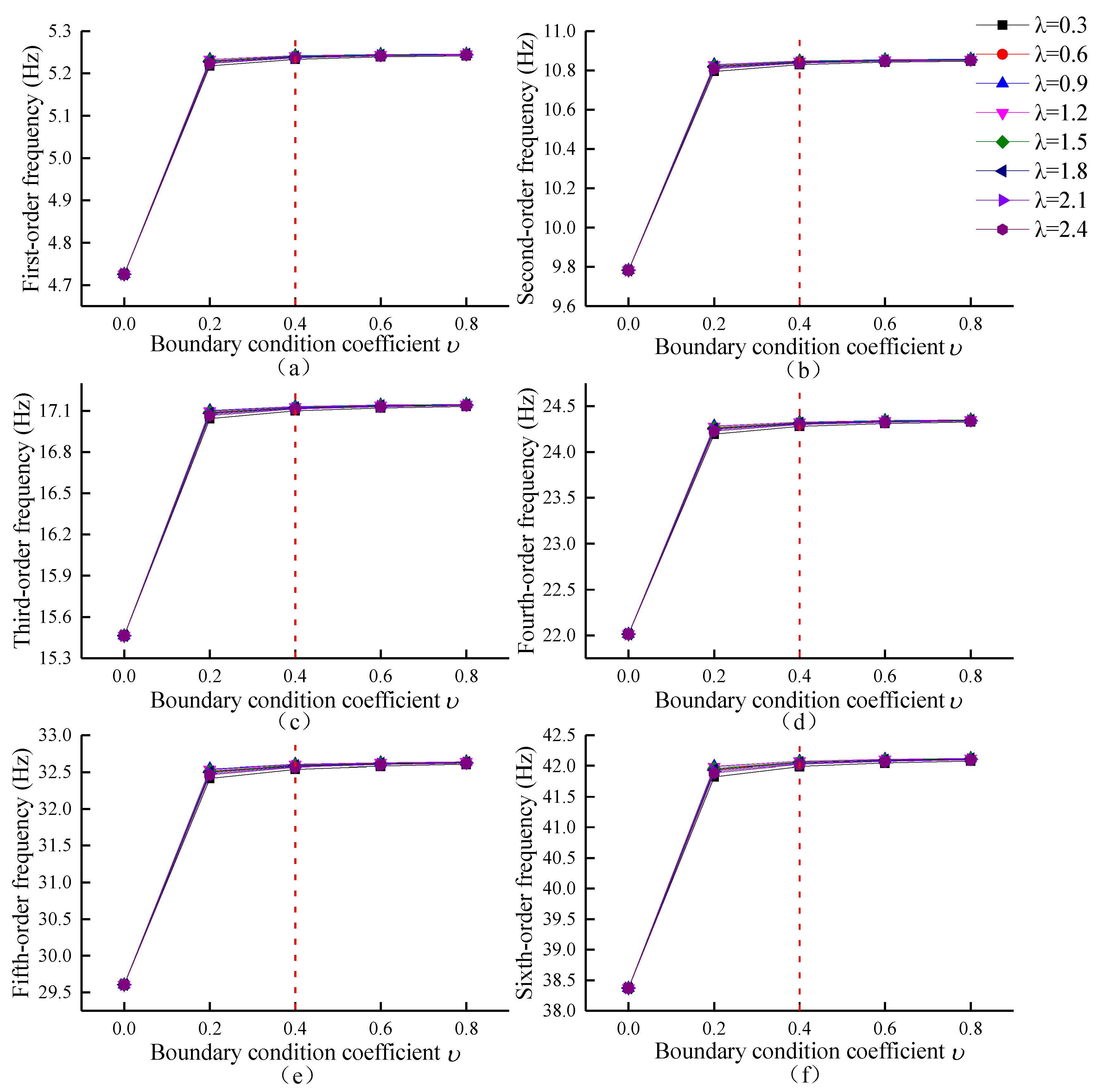Research on the Dynamic Characteristics of Cables Considering the Constraints at Both Ends of the Cables
Abstract
:1. Introduction
2. Basic Theory of Cable Dynamics Analysis
2.1. Basic Equation and Solution
- (1)
- Basic assumptions and vibration control differential equations.
- (2)
- Frequency equation of the cable system
2.2. Description of the Single Cable Boundary Constraint
2.3. Solution of Dynamic Characteristics
2.4. Method Validation
3. Effect of Boundary Conditions on Dynamic Characteristics of Cable
3.1. Effect of Changing Boundary Conditions on Frequency
- (1)
- Ideal state equality boundary
- (2)
- Actual non-equal boundary
3.2. Accuracy Verification of Boundary Condition Range
4. Application Discussion
4.1. Discussion
4.2. Discussion Application
- (1)
- Engineering background
- (2)
- Application verification
5. Conclusions
- (1)
- The analysis of the results of this paper shows that the influence of the stiffness ratio of the upper and lower boundary of the bridge cable on the cable frequency is negligible, and only the influence of the change of the boundary coefficient on the cable frequency needs to be considered.
- (2)
- The boundary condition coefficient is used to describe the cable boundary condition with a certain accuracy, and the actual boundary condition coefficient in this paper can be used to replace the simple and fixed support conditions in the theory. When the cable vibrates transversely and the displacement stiffness of the lateral support at both ends is infinite, the boundary condition coefficient of both ends of the cable reaches 0.4 from 0, and the two ends of the cable change from simple support to fixed support, that is, the rotational stiffness of the cable is , which replaces the case of judging the boundary condition by in the theory.
- (3)
- In actual engineering, the boundary conditions of the cable can be determined from the cable parameters. Both ends of the cable with can be calculated by using simple support boundary; when , the boundary conditions at both ends of the cable shall be treated as a fixed support boundary; when , the boundary at both ends of the cable shall be treated as an elastic complex boundary.
Author Contributions
Funding
Data Availability Statement
Acknowledgments
Conflicts of Interest
Appendix A
References
- Fujino, Y.; Kimura, K.; Tanaka, H. Wind Resistant Design of Bridges in Japan; Springer: Tokyo, Japan, 2014. [Google Scholar]
- Dan, D.; Sun, L.; Guo, Y.; Cheng, W. Study on the Mechanical Properties of Stay Cable HDPE Sheathing Fatigue in Dynamic Bridge Environments. Polymers 2015, 7, 1564–1576. [Google Scholar] [CrossRef] [Green Version]
- Furuya, K.; Kitagawa, M.; Nakamura, S.I.; Suzumura, K. Corrosion Mechanism and Protection Methods for Suspension Bridge Cables. Struct. Eng. Int. 2000, 10, 189–193. [Google Scholar] [CrossRef]
- Main, J.A.; Jones, N.P. Vibration of Tensioned Beams with Intermediate Damper. I: Formulation, Influence of Damper Location. J. Eng. Mech. 2007, 133, 369–378. [Google Scholar] [CrossRef] [Green Version]
- Dan, D.; Xu, B.; Huang, H.; Yan, X.F. Research on the characteristics of transverse dynamic stiffness of an inclined shallow cable. J. Vib. Control 2014, 22, 1609–1610. [Google Scholar] [CrossRef]
- Dan, H.D.; Xu, B.; Chen, Z.H. Universal Characteristic Frequency Equation for Cable Transverse Component System and Its Universal Numerical Solution. J. Eng. Mech. 2016, 142, 4015105. [Google Scholar] [CrossRef]
- Dan, D.H.; Xia, Y.; Xu, B.; Han, F.; Yan, X.F. Multistep and Multiparameter Identification Method for Bridge Cable Systems. J. Bridge Eng. 2018, 23, 04017111. [Google Scholar] [CrossRef]
- Fei, H.; Danhui, D.; Cheng, W.; Jia, P. Analysis on the dynamic characteristic of a tensioned double-beam system with a semi theoretical semi numerical method. Compos. Struct. 2017, 185, 584–599. [Google Scholar] [CrossRef]
- Wang, J.; Wang, F.; Zhou, X. Research on cable force testing of cable-stayed bridges based on fluctuation method. J. Appl. Sci. 2005, 23, 90–93. [Google Scholar]
- Duan, B.; Zeng, D.; Lu, J. Analysis on cable force measurement of cable-stayed bridge. J. Chongqing Jiaotong Univ. 2005, 24, 6–9. [Google Scholar]
- Wei, J. Accuracy analysis of common formulas for cable force measurement. Highw. Traffic Sci. Technol. 2004, 21, 53–56. [Google Scholar]
- Chen, H.; Dong, J.-H. Practical formula of vibration method for determination of sling tension in medium and lower bearing arch bridges. Chin. J. Highw. 2007, 20, 66–70. [Google Scholar]
- Xu, X.; Ren, W. Influence of boundary conditions on the estimation of sling force. J. Railw. Sci. Eng. 2008, 06, 26–31. [Google Scholar]
- Humar, J.L. Dynamics of Structures; Prentice-Hall, Inc.: Englewood Cliffs, NJ, USA, 1990. [Google Scholar]
- Banerjee, J.R. Dynamic stiffness formulation for structural elements: A general approach. Comput. Struct. 1997, 63, 101–103. [Google Scholar] [CrossRef]
- Williams, F.W.; Wittrick, W.H. An automatic computational procedure for calculating natural frequencies of skeletal structures. Int. J. Mech. Sci. 1970, 12, 781–791. [Google Scholar] [CrossRef]
- Wittrick, W.H.; Williams, F.W. A general algorithm for computing natural frequencies of elastic structures. Q. J. Mech. Appl. Math. 1971, 24, 263–284. [Google Scholar] [CrossRef]
- Xing, J.Z.; Wang, Y.G. Free vibrations of a beam with elastic end restraints subject to a constant axial load. Arch. Appl. Mech. 2013, 83, 241–252. [Google Scholar] [CrossRef]
- Su, C.; Xu, Y.F.; Han, D.J. Parameter analysis and identification of bending stiffness of cables in measuring cable force by the frequency method. Highw. Traffic Technol. 2005, 22, 75–78. [Google Scholar]
- Lei, J. Suspension Bridge Design; People’s Traffic Press: Beijing, China, 2002. [Google Scholar]
- Gan, Q. Study on Internal Force Identification Method of Cable Structure under Complex Boundary Conditions; South China University of Technology: Guangzhou, China, 2015. [Google Scholar]






| First-Order Frequency (Hz) | Second-Order Frequency (Hz) | |||||||
|---|---|---|---|---|---|---|---|---|
| Literature [18] | This Article | Literature [18] | This Article | |||||
| 1.0 | 0.002 | 5.169 | 5.327 | 0.66% | 10.406 | 10.420 | 0.13% | |
| 10 | 0.023 | 5.135 | 5.393 | 1.28% | 10.436 | 10.435 | 0.01% | |
| 100 | 0.191 | 5.318 | 5.369 | 1.22% | 10.441 | 10.447 | 0.06% | |
| 0.703 | 5.387 | 5.393 | 0.45% | 10.461 | 10.498 | 0.35% | ||
| Cable Number | ||||||
|---|---|---|---|---|---|---|
| 1 | ||||||
| 2 | ||||||
| 3 | ||||||
| 4 | ||||||
| 5 |
| Modal Order | Measured Value | ||||
|---|---|---|---|---|---|
| 1 | 3.0586 | 3.1097 | 3.1100 | 1.67% | 1.68% |
| 2 | 6.1406 | 6.2367 | 6.2372 | 1.56% | 1.57% |
| 3 | 9.2344 | 9.3979 | 9.3988 | 1.77% | 1.78% |
| 4 | 12.3867 | 12.61 | 12.6114 | 1.80% | 1.81% |
| 5 | 15.6797 | 15.8898 | 15.8912 | 1.34% | 1.35% |
| 6 | 19.0195 | 19.2521 | 19.2539 | 1.22% | 1.23% |
| Cable Number | |||||||
|---|---|---|---|---|---|---|---|
| D1b | |||||||
| D19b | |||||||
| C33 |
| Cable Number | D1b | D19b | C33 | ||||||
|---|---|---|---|---|---|---|---|---|---|
| Measured fundamental frequency (Hz) | 7.23 | 1.88 | 60.06 | ||||||
| Boundary Conditions | Simple support | Elastic support | Fixed support | Simple support | Elastic support | Fixed support | Simple support | Elastic support | Fixed support |
| Calculate fundamental frequency (Hz) | 6.60 | 7.18 | 7.32 | 1.86 | 1.91 | 1.91 | 43.41 | 48.63 | 59.95 |
| Relative error (δ) | 8.71% | 0.69% | 1.24% | 1.06% | 1.60% | 1.60% | 27.72% | 19.03% | 0.18% |
Publisher’s Note: MDPI stays neutral with regard to jurisdictional claims in published maps and institutional affiliations. |
© 2022 by the authors. Licensee MDPI, Basel, Switzerland. This article is an open access article distributed under the terms and conditions of the Creative Commons Attribution (CC BY) license (https://creativecommons.org/licenses/by/4.0/).
Share and Cite
Dan, D.; Liao, X.; Han, F. Research on the Dynamic Characteristics of Cables Considering the Constraints at Both Ends of the Cables. Appl. Sci. 2022, 12, 2100. https://doi.org/10.3390/app12042100
Dan D, Liao X, Han F. Research on the Dynamic Characteristics of Cables Considering the Constraints at Both Ends of the Cables. Applied Sciences. 2022; 12(4):2100. https://doi.org/10.3390/app12042100
Chicago/Turabian StyleDan, Danhui, Xia Liao, and Fei Han. 2022. "Research on the Dynamic Characteristics of Cables Considering the Constraints at Both Ends of the Cables" Applied Sciences 12, no. 4: 2100. https://doi.org/10.3390/app12042100





